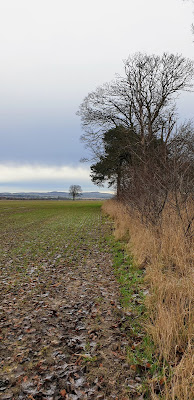When I said that people feel perfectly entitled to regularly tell dog owners what to do it is no exaggeration. I wrote the piece about dogs only yesterday and along came an example, bang on cue.
Upon Moncreiffe hill, a sturdy man rounded a corner. He was kitted out in traditional country clothes and wielded a staff nearly as big as himself . I, poleless, had just puffed my way up the steep southwesterly corner from where the path runs closest to the motorway. It then rises in an easterly curve, doubling back on itself towards the lower hillfort, Moncreiffe (185m).
I had no opportunity to apologise to the chap with the big stick. He told me in no uncertain terms I should keep the dog tethered. Despite decades of experience, my usual response when confronted is shock. With the ghost of a presence of mind usually lacking I countered that actually, I hadn't seen anyone in forty five minutes. But he disagreed, grunted and dissatisfied and unswayed went his own way.
I had actually been walking one of the steeper, smaller, less well trodden tracks. As it turned out, in 90 minutes or 4.5 miles I was to see only this man and one couple near the car park. The forest is large with few people compared to its size, particularly in winter as potholed routes to steep, icy car parks dissuade.
 |
| Typical track in Moncreiffe forest |
Why do people do this? I don't waylay joggers and tell them to keep their heavy breathing and spittle to themselves. I don't stop the occasional family or group taking up the whole path and ask them for some space. I don't harangue the odd over-enthusiastic cyclist who bombs out on to a walking path where I am with my frail and elderly parents. I get shocks and scares from all of these things but I don't accost the culprits. I don't think most people do, so why do some become so officious and entitled over dogs? Were I a man with a big stick I would not start giving a woman alone in a forest a piece of my mind.
When people say what Perthites are known for compared to other cities: self-righteousness; looking down on people, sniffiness, disapproval, is this what they mean? I am reasonably immune to stares and dirty looks and have trained myself to not even notice them, yet still remember with astonishment those I used to get twelve or thirteen years simply for using a donated bike trailer for transporting my kids to nursery along Tay Street. What new-fangled idea is that? What does she think she's doing? Later, despite having got used to Perth's extraordinary whiteness I remember being horrified and yet not altogether surprised upon being told that there were racist remarks going around some parents in the playground about other parents from a different country.
I lived in London for five years, in Paris, in Edinburgh and generally in much more crowded places where tolerance is a necessity because of the greater diversity of the population. But there are many places unused to diversity, moreover, habituated to a hierarachy and pecking order, where some people and indeed their families, may have been somewhere near the top for decades. Neither town, council, nor rural society is immune to getting used to privilege, bossing people about and disliking being answered back. It is a huge fallacy that this is just an English thing.
This man may have had a momentary scare from a barking dog of small to medium stature, for which I am deeply sorry, but does that mean one can go about making unreasonable demands that dogs should be permanently tethered in empty forests? And actually how often are men scared, walking? As a female who usually walks alone I am always scared. Not just of falls or getting lost, which applies to either sex, but of nutters who attack women. Just because I am female I have been terrified at worst, nervous at best, all my life of walking alone - in the country, in cities and especially at night. Luckily, I am six foot tall, sturdily built and reasonably fit. I am delighted to also now have a very protective dog and sometimes poles and other accoutrements but the fact that I am aware of things I might have to hand to defend myself is indicative that I, like many women often do feel worried simply walking.
They shake you up, these encounters. I console myself not with shouting back but later with fantasies of a post-apocalyptic Scotland in which free-roaming wolf-dog crosses have inherited the character assessment abilities of dogs like mine and tear the officious and judgemental apart leaving bloody trails and mangled body parts in the snow...
Engaged in such reveries, as I descended Moncreiffe fort I slipped on some ice, turned in mid air at the kind of angle I dreamt of as an eight-year-old wannabe gymnast and faceplanted into a molehill, luckily fresh. I heard from childhood my father's voice, amused, mocking: "God, punishing". I ignored it as I spat out earth, rubbed soil out of my eye and salvaged my specs. And who was there as I tested my limbs for breaks and sprains on top of the hill with an hour left of light? A well-meaning knight holding out his staff at a safe two metre distance to let me haul myself up? No. But there was my hound rushing back to see what had happened; licking mud off my face, performing a dance more often seen at dinnertime and expressing an optimism and concern which, translated, impossibly into speech might have said: "Are you OK? It's fine, you'll be fine, I'm here, and I can't help at all in any practical way whatsoever but I'm with you", the general effect being: who better, for moral support?
In practice, carry spare specs.
 |
| View over Bridge of Earn |






















